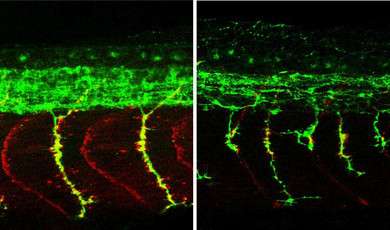Discovery of a key factor in the development of the peripheral nervous system

In both humans and animals, voluntary movement is the result of a complex and precisely-coordinated interplay of nerves, muscles and bones. How does this 'neuromuscular unit' develop during early embryonic development, and which genes are involved? "This is the question we asked ourselves, particularly in the case of certain patients born with broken bones who, even as newborns, were neither able to move properly nor breathe unaided," explains Dr. Ellen Knierim, a researcher at Charité's NeuroCure Clinical Research Center and the study's first author. "Our attempts to determine the causes behind the disorder were greatly aided by gene sequencing technology and biocomputational analysis," adds Dr. Knierim.
Using these techniques, the researchers were able to discover mutations in the ASC-1 protein complex of affected patients. They found that ASC-1 controls numerous factors responsible for guiding the development of peripheral motor neurons, as they grow from their places of origin inside the spinal cord to their respective target muscles. At the same time, researchers led by Prof. Hiromi Hirata from Japan's Aoyama Gakuin University conducted research to establish the function of the ASC-1 complex in zebrafish, where its deliberate elimination leads to paralysis. Using the fish's virtually transparent larvae, Hirata was able to show that nerve cells emanating from the spinal cord were unable to find their target muscles.
"As a 'transcription factor', the ASC-1 complex controls the activity of nerve growth factors by switching them on and off as required," explains Prof. Markus Schuelke, who heads the research group at Charité. "In a manner reminiscent of crash barriers ensuring a vehicle does not leave the road, these factors effectively keep the growing nerve cells on the right track, ensuring they safely reach their intended destinations." Additional experiments conducted by the group showed that the ASC-1 complex works in cooperation with a specific protein (CSRP1). The protein itself has been known to researchers for some time as a result of research on zebrafish, where it plays an important role in the healing process following damage to the spinal cord. In contrast to humans, zebrafish are able to regenerate their spinal cord, even if it has been completely severed. It would appear that the CSRP1 protein plays an important role in this process.
Prof. Schuelke emphasizes: "Our results are a good example of how the study of rare genetic diseases can provide insights into general disease mechanisms, which may also play a role in other conditions, such as paraplegia, and which may give rise to the development of regenerative therapies."
More information: Ellen Knierim et al. Mutations in Subunits of the Activating Signal Cointegrator 1 Complex Are Associated with Prenatal Spinal Muscular Atrophy and Congenital Bone Fractures, The American Journal of Human Genetics (2016). DOI: 10.1016/j.ajhg.2016.01.006


















